Integration of Profile Control and Thermal Recovery to Enhance Heavy Oil Recovery
Abstract
1. Introduction
2. Experimental Section
2.1. Materials
2.2. Instruments
Viscosity
2.3. Experimental Procedures
2.3.1. Heavy Oil Threshold Pressure Tests
2.3.2. Inorganic Gel Plugging Experiments
2.3.3. Simulation of Thermal Recovery
2.3.4. Oil Displacement Experiments
3. Results and Discussions
3.1. Relationship between Heavy Oil Viscosity and Temperature
3.2. Heavy Oil Threshold Pressure
3.3. Properties of Profile Control Agents
3.3.1. Microstructure of Profile Control Agents
3.3.2. Plugging Performance of Profile Control Agents
3.4. Thermal Recovery Effects
3.4.1. Effects of Crude Oil Viscosity
3.4.2. Effects of Swept Areas on Thermal Recovery
- (1)
- Influence of swept areas
- (2)
- Effects of oil viscosity gradient on the thermal recovery
3.5. Oil Recovery through Proposed Integrated Technology in Inverted Nine-Point Well Pattern
4. Conclusions
- The viscosity of heavy oil from Bohai Oilfield N was strongly temperature-dependent, and the heavy oil could be subjected to thermal recovery. Additionally, the flow threshold pressure of the oil decreased with the increase of the temperature.
- Inorganic gels exhibited high temperature tolerance and plugging performance owing to their denser structures at high temperatures (55–140 °C). In contrast, polymer gels exhibited poor temperature tolerance at high temperatures. The molecular chains of polymer gels cracked after a treatment of 5 d at 140 °C. The plugging rate of inorganic gels with a concentration of 4–6% was 99% for the core with a permeability of 2000 × 10−3 μm2.
- The thermal recovery process was implemented in the laboratory by suturing the core with crude oil with different viscosities to simulate the oil in areas swept by the thermal fluid. The oil recovery associated with the thermal recovery in the heterogeneous core increased from 10.8% at 55 °C to 42.9% at 200 °C. Moreover, the oil recovery associated with thermal recovery assisted by profile control increased from 8.9% to 13.2%. The areas swept by the thermal fluid were optimized at 3/10 of the injector–producer distance with three slugs of oils with different viscosities.
- The integration of profile control and thermal recovery resulted in a synergistic effect that enhanced the oil recovery (9.4%) compared to the total oil recovery (8.0%) of profile control and thermal recovery in an inverted nine-point well pattern model. The synergistic effect can be attributed to the higher vertical and horizontal sweep efficiencies after profile control at lower oil viscosities with thermal recovery. The increased swept volume in the area with lower oil viscosity ensured that the oil recovery was higher than the total oil recovery of profile control and thermal recovery.
- Although the inorganic gel dissector has good temperature resistance, there is still room to improve the profile control effect. Developing more efficient temperature resistant dissectors and combining profile control and autogenous heat is the next research development direction.
Author Contributions
Funding
Institutional Review Board Statement
Informed Consent Statement
Data Availability Statement
Conflicts of Interest
References
- Xie, Z.; Feng, Q.; Zhang, J.; Shao, X.; Zhang, X.; Wang, Z. Prediction of Conformance Control Performance for Cyclic-Steam-Stimulated Horizontal Well Using the XG Boost: A Case Study in the Chunfeng Heavy Oil Reservoir. Energies 2021, 14, 8161. [Google Scholar] [CrossRef]
- Zhou, Z.; Slaný, M.; Kuzielová, E.; Zhang, W.; Ma, L.; Dong, S.; Zhang, J.; Chen, G. Influence of reservoir minerals and ethanol on catalytic aquathermolysis of heavy oil. Fuel 2022, 307, 121871. [Google Scholar] [CrossRef]
- Mukhamatdinov, I.I.; Salih Indad, S.S.; Khelkhal, M.A.; Vakhin, A.V. Application of Aromatic and Industrial Solvents for Enhancing Heavy Oil Recovery from the Ashalcha Field. Energy Fuels 2021, 35, 374–385. [Google Scholar] [CrossRef]
- Liu, H.; Dong, X. Current status and future trends of hybrid thermal EOR processes in heavy oil reservoirs. Pet. Sci. Bull. 2022, 7, 174–184. [Google Scholar]
- Zhou, S.; Li, Q.; Zhu, H.; Zhang, H.; Fu, Q.; Zhang, L. The Current State and Future of Offshore Energy Exploration and Development Technology. Strateg. Study CAE 2016, 18, 19–31. [Google Scholar]
- Jia, C. Challenges facing upstream development of China’s petroleum industry and future scientific and technological breakthroughs. Acta Pet. Sin. 2020, 41, 1445–1464. [Google Scholar]
- Tian, H.; Deng, J.; Meng, Y.; Zeng, X.; Sun, F. Laboratory simulation on sand production of heavy oil reservoir in Bohai area. Acta Pet. Sin. 2005, 26, 85–87. [Google Scholar]
- Shan, J.; Liu, Y.; Lu, X. Application of polymer flooding in Luda 10-1 oilfield in Bohai Sea. Offshore Oil 2009, 29, 47–53. [Google Scholar]
- Kang, X.; Zhang, J. Surfactant Polymer (SP) flooding Pilot Test on Offshore Heavy Oil Field in Bohai Bay, China; SPE 165224. 2013. Available online: https://chem.ckcest.cn/Proceeding/Details/323397 (accessed on 2 July 2013).
- Han, M.; Xiang, W.; Zhang, J.; Jiang, W.; Sun, F. Application of EOR Technology by Means of Polymer Flooding in Bohai Oilfields; SPE 104432. 2006. Available online: https://xueshu.baidu.com/usercenter/paper/show?paperid=150q0jr0x97d0jn0a71x04d0kg234591 (accessed on 1 December 2006).
- Song, S.; Wang, Y.; Zhou, J.; Meng, X. Early development of common heavy oil reservoir by water flooding controlled by movable gel. Pet. Explor. Dev. 2007, 34, 585–589. [Google Scholar]
- Guo, Y.; Zhang, J.; Liu, Y.; Liu, G.; Xue, X.; Luo, P.; Ye, Z.; Zhang, X.; Liang, Y. Successful Scale Application of Associative Polymer Flooding for Offshore Heavy Oilfield in Bohai Bay of China. In SPE/IATMI Asia Pacific Oil & Gas Conference and Exhibition, Bali, Indonesia, 29–31 October 2019; SPE 196467; OnePetro: Richardson, TX, USA, 2020; Available online: https://onepetro.org/SPEAPOG/proceedings/19APOG/1-19APOG/D012S003R010/217345 (accessed on 31 August 2022).
- Zhu, D.; Hou, J.; Chen, Y.; Wei, Q.; Zhao, S.; Bai, B. Evaluation of Terpolymer-Gel Systems Crosslinked by Polyethylenimine for Conformance Improvement in High-Temperature Reservoirs. SPE J. 2019, 24, 1726–1740. [Google Scholar]
- Liu, Y.; Dai, C.; Wang, K.; Zou, C.; Gao, M.; Fang, Y.; Zhao, M.; Wu, Y.; You, Q. Study on A Novel Cross-Linked Polymer Gel Strengthened with Silica Nanoparticles. Energy Fuel 2017, 31, 9152–9161. [Google Scholar] [CrossRef]
- Wang, F.; Li, Z.; Li, S.; Chen, H. Profile control mechanism experiment of autogenic thermal foam system. J. China Univ. Pet. Nat. Sci. 2017, 41, 116–123. [Google Scholar]
- Yang, H.; Pan, H.; Zhang, Y.; Zhong, X. Inhibition effect of oxygen reduction on downhole pipe string by air foam flooding and its limit of oxygen reduction. Acta Pet. Sin. 2019, 40, 99–107. [Google Scholar]
- Tang, X.; Yang, L.; Liu, Y.; Li, Z.; Chang, Z.; Li, Y.; Wei, F. New inorganic gel coating deep fluid transfer agent. Pet. Explor. Dev. 2012, 39, 76–81. [Google Scholar] [CrossRef]
- Pham, L.T.; Hatzignatiou, D.G. Rheological Evaluation of A Sodium Silicate Gel System for Water Management in Mature, Naturally-Fractured Oilfields. J. Petrol. Sci. Eng. 2016, 138, 218–233. [Google Scholar] [CrossRef]
- Zhao, J.; Zhang, J. Research and Advances of Silicate Plugging Agent in the Oilfields. J. Mater. Sci. Chem. Eng. 2019, 7, 1–10. [Google Scholar] [CrossRef]
- Hatzignatiou, D.G.; Askarinezhad, R.; Giske, N.H.; Stavland, A. Laboratory Testing of Environmentally Friendly Sodium Silicate Systems for Water Management Through Conformance Control. SPE Prod. Oper. 2016, 31, 337–350. [Google Scholar] [CrossRef]
- Sun, Y.; Li, Z.; Lin, T.; Sun, Y.; Liu, H.; Song, H.; Li, S. Experimental Research on the Control of Gas Channeling by Thermo-sensitive Gel on Offshore Heavy Oil. Oilfield Chem. 2020, 37, 266–272. [Google Scholar]
- Cheng, W.; Han, B. Wellbore heat transfer model of multiple thermal fluids based on actual gas state equation. Acta Pet. Sin. 2015, 36, 1402–1410. [Google Scholar]
- Yu, X.; Liu, X.; Chen, M.; Wu, G.; Li, X. Study on Influence of Heavy Oil Reservoir Damage Caused by Multi-Component Thermal Fluid Huff and Puff. Front. Energy Res. 2022, 821221. [Google Scholar] [CrossRef]
- Li, Z.; Sun, Y.; Lu, T.; Hou, D.; Li, B.; Li, S. Three-dimensional physical simulation of thermochemical flooding in offshore heavy oil. J. China Univ. Pet. Nat. Sci. 2020, 44, 85–90. [Google Scholar]
- Zhang, F.; Liao, H.; Yang, D.; Wu, T.; Ge, T.; Du, C.; Geng, Z. Experimental study on 3d physical simulation of SAGD development in offshore deep massive extra-heavy oil. Chem. Eng. Oil Gas 2019, 48, 90–94. [Google Scholar]
- Huang, C.; Huang, S.; Cheng, L.; Wei, S.; Liu, S. Two-Dimensional Physical Simulation Device for Thermal Recovery of Horizontal Wells in Heavy Oil Reservoirs. Beijing Patent CN204267010U, 15 April 2015. [Google Scholar]
- Xie, K.; Cao, B.; Lu, X.; Jiang, W.; Zhang, Y.; Li, Q.; Song, K.; Liu, J.; Wang, W.; Lv, J.; et al. Matching between the diameter of the aggregates of hydrophobically associating polymers and reservoir pore-throat size during polymer flooding in an offshore oilfield. J. Pet. Sci. Eng. 2019, 177, 558–569. [Google Scholar] [CrossRef]
- Xie, K.; Lu, X.; Pan, H.; Han, D.; Hu, G.; Zhang, J.; Zhang, B.; Cao, B. Analysis of dynamic imbibition effect of surfactant in micro cracks in reservoir with high temperature and low permeability. SPE Prod. Oper. 2018, 33, 596–606. [Google Scholar]
- Cao, W.; Xie, K.; Lu, X.; Ding, H.; Xiao, Z.; Cao, W.; Zhou, Y.; He, X.; Li, Y.; Li, H. The effect of profile-control oil-displacement agent on increasing oil recovery and its mechanism. Fuel 2019, 11, 51–1160. [Google Scholar] [CrossRef]
- Cao, B.; Lu, X.; Xie, K.; Ding, H.; Xiao, Z.; Cao, W.; Zhou, Y.; He, X.; Li, Y.; Li, H. The pore-scale mechanisms of surfactant-assisted spontaneous and forced imbibition in water-wet tight oil reservoirs. J. Pet. Sci. Eng. 2022, 213, 110371. [Google Scholar] [CrossRef]
- Cui, C.; Zheng, W.; Zhu, Y.; Yuan, F.; Xiao, X.; Wu, Z.; Teng, S. Method for determining limit well spacing of chemical flooding after reservoir steam soak in heavy oil reservoir. J. China Univ. Pet. Nat. Sci. 2022, 46, 97–103. [Google Scholar]
- Yang, J.; Li, X.; Chen, Z.; Tian, J.; Huang, L.; Liu, X. Steam stimulation productivity prediction model considering non-Newtonian properties of heavy oil. Acta Pet. Sin. 2017, 38, 84–90. [Google Scholar]
- Zheng, H. Rheological Properties of Non-Newtonian Crude oil Percolation and Its Application in Oilfield Development. J. Jianghan Pet. Inst. 2003, 25, 90–91. [Google Scholar]
- Wang, Y.; Zhao, Q.; Zhou, S. Effect of temperature on microstructure of hydrated calcium silicate synthesized by solution method. B Chin. Ceram. Soc. 2018, 37, 2817–2821. [Google Scholar]
- Lei, Y.; Han, T.; Wang, H.; Jin, X.; Yang, F.; Cao, H.; Cheng, F. Preparation and characterization of calcium silicate hydrate (C-S-H) by hydrothermal synthesis. B Chin. Ceram. Soc. 2014, 33, 465–469. [Google Scholar]
- Lothenbach, B.; Scrivener, K.; Hooton, R.D. Supplementary Cementitious Materials. Cem. Concr. Res. 2011, 41, 1244–1256. [Google Scholar] [CrossRef]
- Liu, J.; Lu, X.; Wang, R.; Liu, Y.; Zhang, S. Performance evaluation and oil displacement mechanism of special viscoelastic fluid at high salinity. J. China Univ. Pet. Nat. Sci. 2013, 37, 159–166. [Google Scholar]
- Liu, J.; Lu, X.; Zhang, Y.; Cao, W.; Xie, K.; Pan, H.; Zhao, J.; Li, G. Effect of Surfactants and bases on gelling effect of Cr~(3+) polyacrylamide gel and its mechanism. Acta Pet. Sin. Pet Process Sect. 2018, 34, 614–622. [Google Scholar]
- Cao, B.; Xie, K.; Lu, X.; Cao, W.; He, X.; Xiao, Z.; Zhang, Y.; Wang, X.; Su, C. Effect and mechanism of combined operation of profile modification and water shutoff with in-depth displacement in high-heterogeneity oil reservoirs. Colloid Surf. A 2021, 631, 127673. [Google Scholar] [CrossRef]
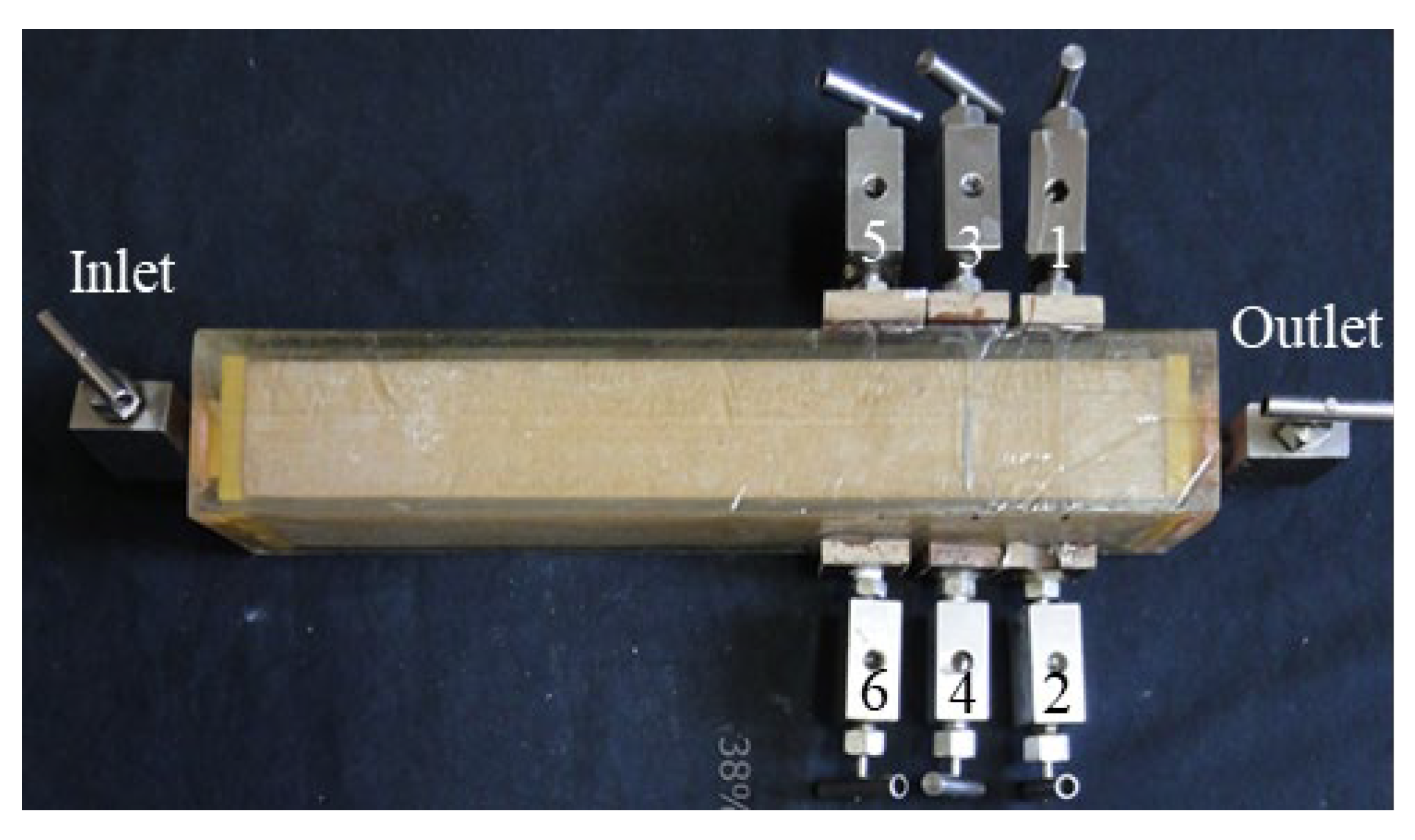


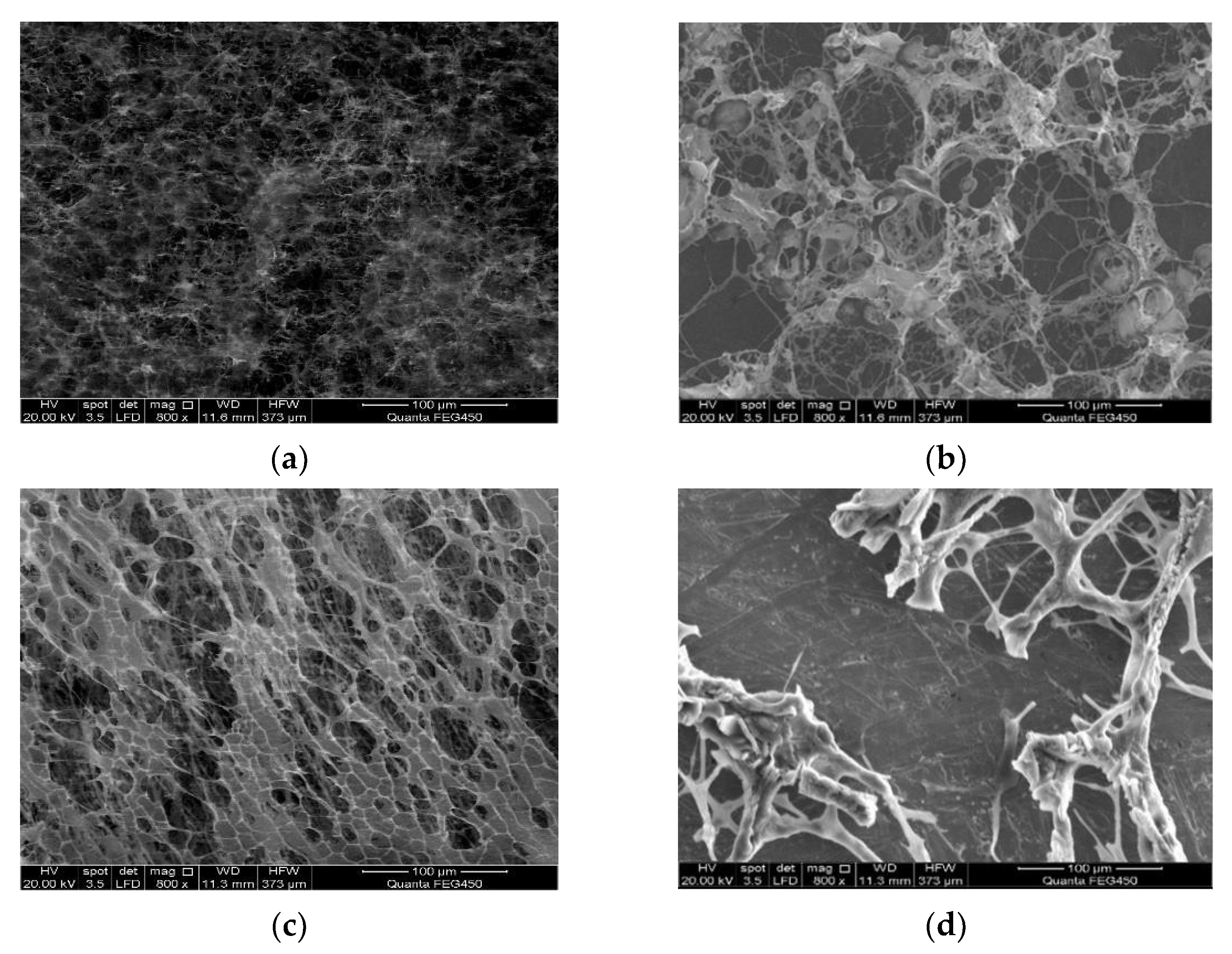


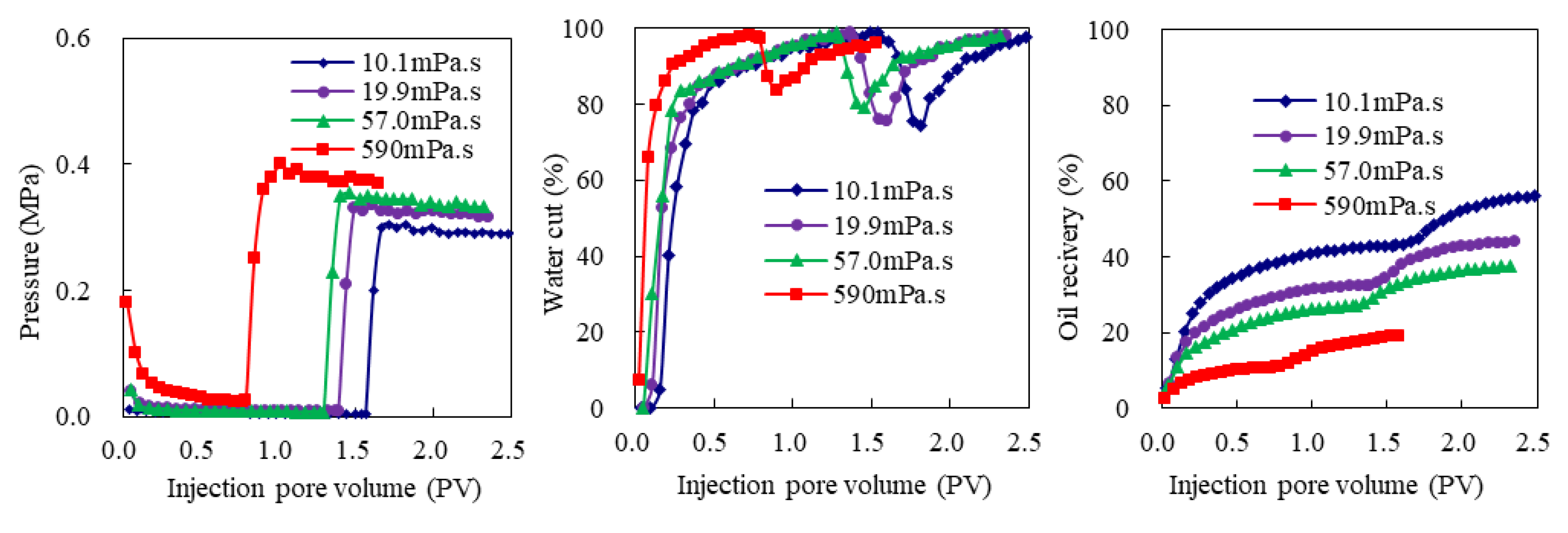

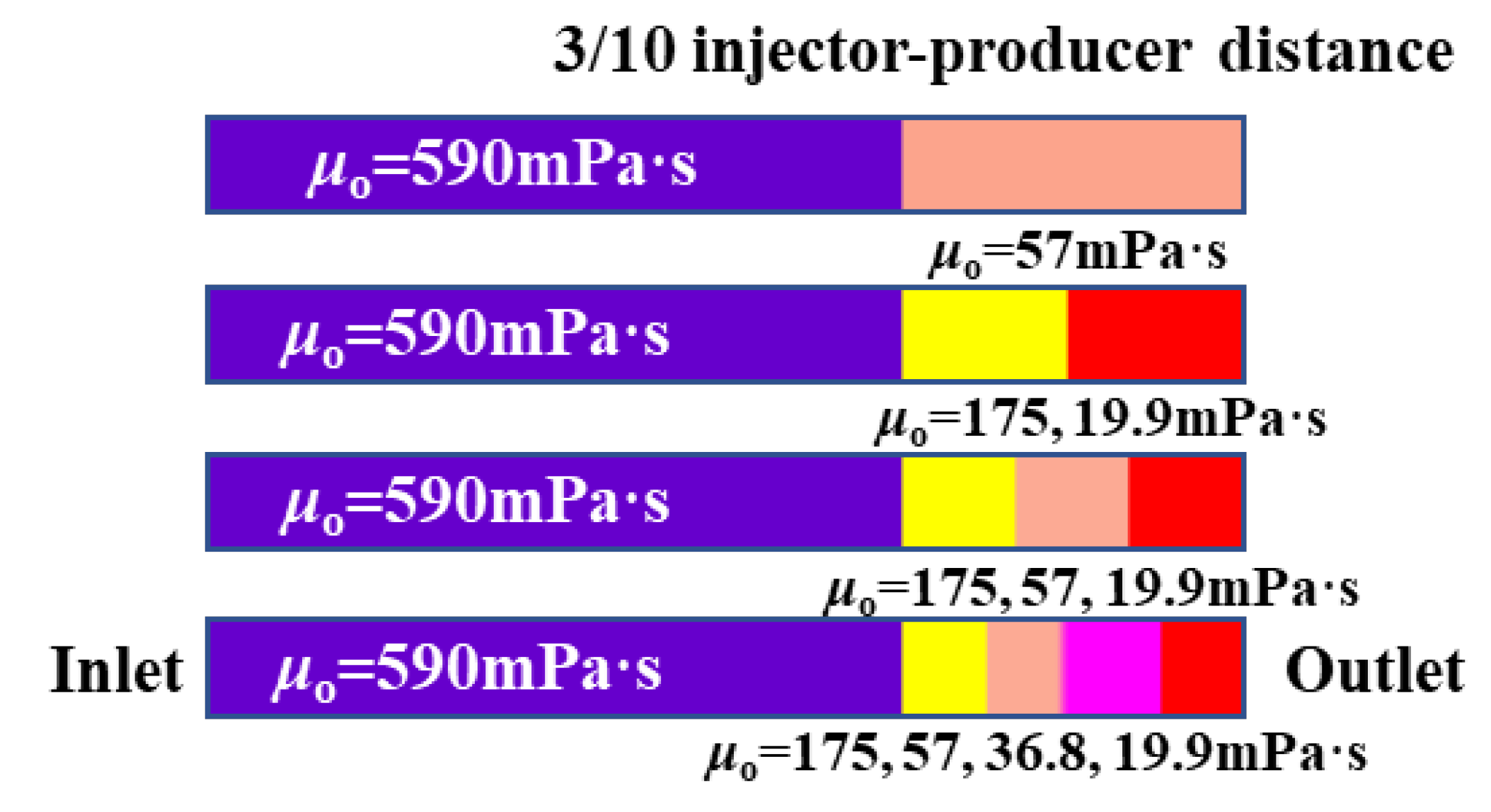




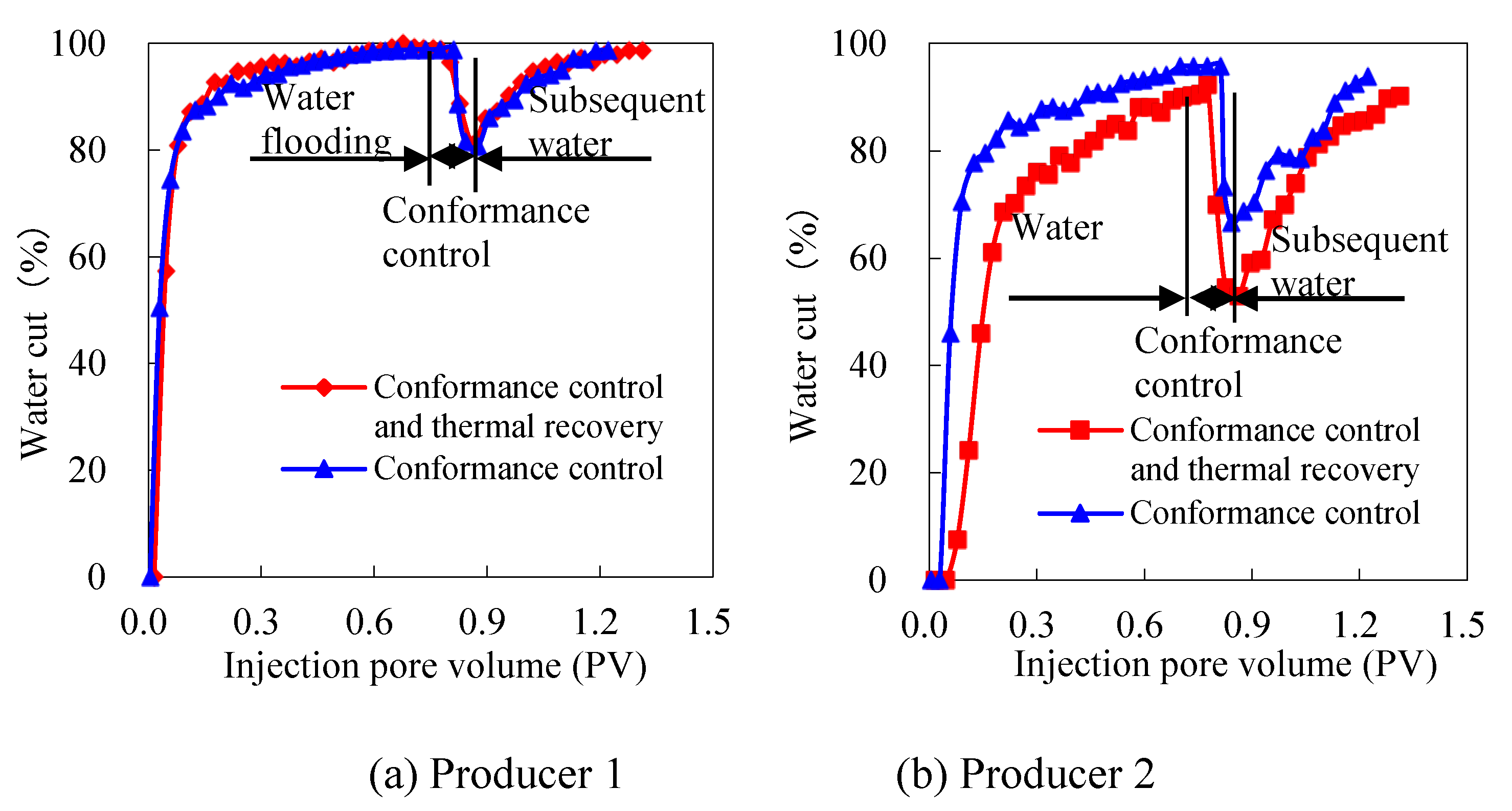
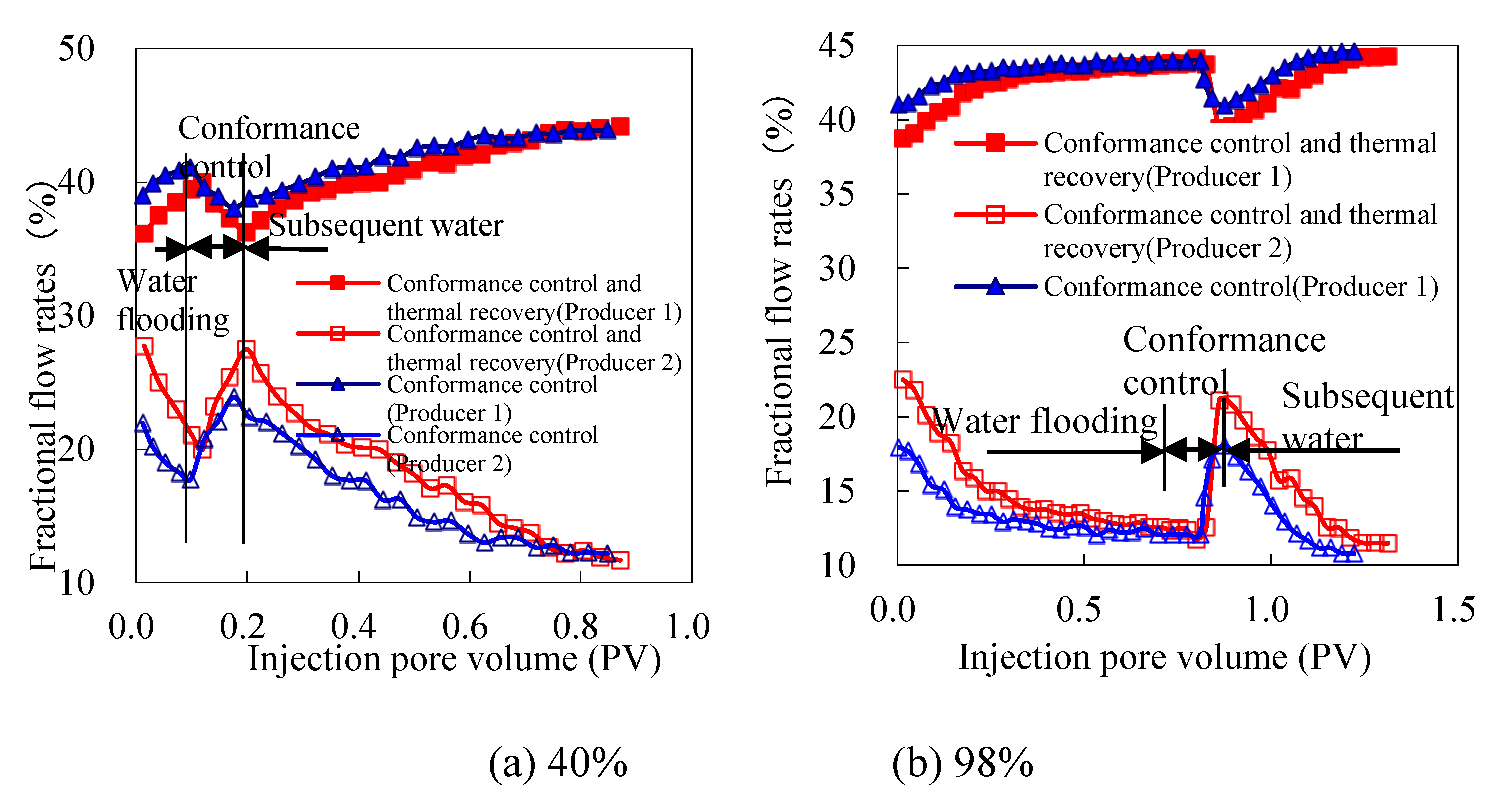

| Temperature (°C) | 50 | 55 | 60 | 70 | 80 | 90 | 100 | 120 | 140 | 150 | 160 | 180 | 200 |
|---|---|---|---|---|---|---|---|---|---|---|---|---|---|
| Viscosity (mPa·s) | 925 ± 19 | 590 ± 5.8 | 470 ± 11.2 | 297 ± 7.5 | 175 ± 1.8 | 87 ± 1.7 | 57 ± 1.5 | 36.8 ± 0.6 | 25.6 ± 0.5 | 19.9 ± 0.2 | 15.8 ± 0.3 | 12.7 ± 0.2 | 10.8 ± 0.2 |
| Parameters | Concentration of Main and Auxiliary Agents (%) | Permeability Kw(×10−3 μm2) | Resistance factor | Residual Resistance factor | Plugging Rate (%) | ||
|---|---|---|---|---|---|---|---|
| Scheme | Before Profile Control | After Profile Control | |||||
| 1-1 | 0.25 | 855 | 195 | 3.46 | 3.46 | 77.2 | |
| 1-2 | 0.5 | 966 | 167 | 6.26 | 6.52 | 82.7 | |
| 1-3 | 1.0 | 945 | 125 | 8.65 | 9.23 | 86.8 | |
| 1-4 | 2.0 | 850 | 60 | 36.52 | 45.65 | 93.0 | |
| 1-5 | 4.0 | 880 | 9 | 65.00 | 93.75 | 99.0 | |
| 1-6 | 6.0 | 940 | 9 | 66.92 | 98.08 | 99.1 | |
| Scheme | Water Cut at the Beginning of Agent Injection (%) | Oil Viscosity (mPa·s) | Oil Saturation (%) | Oil Recovery (%) | ||
|---|---|---|---|---|---|---|
| Water Flooding | After Water Injection | Incremental | ||||
| 2-1 | 40 | 590 | 79.5 | 3.5 | 23.3 | 12.5 |
| 2-2 | 98 | 80.5 | 10.8 | 19.7 | 8.9 | |
| 2-3 | 40 | 57.0 | 78.8 | 11.0 | 41.0 | 14.0 |
| 2-4 | 98 | 78.5 | 27.0 | 37.6 | 10.6 | |
| 2-5 | 40 | 19.9 | 77.1 | 14.8 | 49.8 | 17.4 |
| 2-6 | 98 | 76.7 | 32.4 | 43.9 | 11.5 | |
| 2-7 | 40 | 10.8 | 73.3 | 23.4 | 61.2 | 18.3 |
| 2-8 | 98 | 73.5 | 42.9 | 56.1 | 13.2 | |
| Scheme No. | Displacement Method | Area Swept by Thermal Recovery | Oil Saturation (%) | Oil Recovery (%) | |
|---|---|---|---|---|---|
| Water Flooding | Increment | ||||
| 2-9 | Water flooding | - | 80.5 | 10.8 | - |
| 2-10 | Water flooding and thermal recovery | 1/10 | 80.5 | 11.4 | 1.2 |
| 2-11 | 2/10 | 80.1 | 12.8 | 2.6 | |
| 2-12 | 3/10 | 79.5 | 14.3 | 4.1 | |
| 2-13 | 4/10 | 79.3 | 16.0 | 5.8 | |
| 2-14 | 5/10 | 78.8 | 17.7 | 7.5 | |
| Scheme No. | Displacement Mode | Oil Viscosity (mPa·s) | Oil Saturation (%) | Oil Recovery (%) | |
|---|---|---|---|---|---|
| Water Flooding | Increment | ||||
| 2-9 | Water flooding | 590 | 80.5 | 10.8 | - |
| 2-15 | Water flooding and thermal recovery | 57.0 | 79.7 | 14.3 | 3.5 |
| 2-16 | 175, 19.9 | 78.9 | 15.9 | 5.1 | |
| 2-17 | 175, 57.0, 19.9 | 79.5 | 16.4 | 5.6 | |
| 2-18 | 175, 57.0, 36.8, 19.9 | 79.1 | 15.6 | 5.8 | |
| Scheme No. | Displacement Method | Water Cut for Profile Control Injection (%) | Oil Saturation (%) | Oil Recovery (%) | ||
|---|---|---|---|---|---|---|
| Water Flooding | Final | Increment | ||||
| 3-1 | Water flooding | - | 78.7 | 8.7 | - | - |
| 3-2 | Water flooding and thermal recovery | 98 | 78.0 | 11.5 | - | 2.7 |
| 3-3 | Profile control | 40 | 78.5 | 2.8 | 19.6 | 10.9 |
| 3-4 | Profile control | 98 | 78.7 | 8.7 | 14.0 | 5.3 |
| 3-5 | Profile control and thermal recovery | 40 | 78.2 | 3.8 | 23.8 | 15.1 |
| 3-6 | Profile control and thermal recovery | 98 | 78.0 | 11.5 | 18.1 | 9.4 |
Publisher’s Note: MDPI stays neutral with regard to jurisdictional claims in published maps and institutional affiliations. |
© 2022 by the authors. Licensee MDPI, Basel, Switzerland. This article is an open access article distributed under the terms and conditions of the Creative Commons Attribution (CC BY) license (https://creativecommons.org/licenses/by/4.0/).
Share and Cite
Wang, Q.; Zheng, W.; Liu, J.; Cao, B.; Hao, J.; Lu, X.; Zheng, K.; Cui, L.; Cui, T.; Sun, H. Integration of Profile Control and Thermal Recovery to Enhance Heavy Oil Recovery. Energies 2022, 15, 7346. https://doi.org/10.3390/en15197346
Wang Q, Zheng W, Liu J, Cao B, Hao J, Lu X, Zheng K, Cui L, Cui T, Sun H. Integration of Profile Control and Thermal Recovery to Enhance Heavy Oil Recovery. Energies. 2022; 15(19):7346. https://doi.org/10.3390/en15197346
Chicago/Turabian StyleWang, Qiuxia, Wei Zheng, Jinxiang Liu, Bao Cao, Jingbin Hao, Xiangguo Lu, Kaiqi Zheng, Longchao Cui, Tianyu Cui, and Huiru Sun. 2022. "Integration of Profile Control and Thermal Recovery to Enhance Heavy Oil Recovery" Energies 15, no. 19: 7346. https://doi.org/10.3390/en15197346
APA StyleWang, Q., Zheng, W., Liu, J., Cao, B., Hao, J., Lu, X., Zheng, K., Cui, L., Cui, T., & Sun, H. (2022). Integration of Profile Control and Thermal Recovery to Enhance Heavy Oil Recovery. Energies, 15(19), 7346. https://doi.org/10.3390/en15197346





